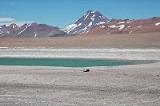
Acamarachi
Encyclopedia
Acamarachi, also known as Pili, is a stratovolcano
located northeast of the volcanoes Aguas Calientes
and Lascar
, and southwest of the sector Salar de Pujsa of Los Flamencos National Reserve
, in the Antofagasta Region
of Chile
. The volcano lies on a high plateau called Puna de Atacama
.
It has a steep-sided cone with slopes of up to 45 degrees. It is at the southeast end of a small volcano group stretching to Colachi to the northwest. It has an old summit crater with a summit lava flow thought to date from the Holocene
era. A small crater lake
about 10–15 m in diameter is found within the crater. This is most likely the second highest crater lake in the world, and also the second highest lake of any kind in South America
, behind the crater lake of Ojos del Salado
.
in San Pedro de Atacama.
Stratovolcano
A stratovolcano, also known as a composite volcano, is a tall, conical volcano built up by many layers of hardened lava, tephra, pumice, and volcanic ash. Unlike shield volcanoes, stratovolcanoes are characterized by a steep profile and periodic, explosive eruptions...
located northeast of the volcanoes Aguas Calientes
Aguas Calientes (volcano)
Aguas Calientes Volcano or Cerro Aguas Calientes, also called Simbad, is a cone-shaped stratovolcano located east of the Lascar volcano and directly north of Laguna Lejía, in Chile's II Region...
and Lascar
Lascar Volcano
-Geographical setting:Lascar is located in the altiplano of the Antofagasta Region of northern Chile, east of the Salar de Atacama, immediately west of the Aguas Calientes volcano, and to the northeast of Laguna Lejía...
, and southwest of the sector Salar de Pujsa of Los Flamencos National Reserve
Los Flamencos National Reserve
Los Flamencos National Reserve is a nature reserve located in the commune of San Pedro de Atacama, Antofagasta Region of Chile. The reserve covers a total area of in the Central Andean dry puna ecoregion and consists of seven separate sectors....
, in the Antofagasta Region
Antofagasta Region
The II Antofagasta Region is one of Chile's fifteen first-order administrative divisions. It comprises three provinces, Antofagasta, El Loa and Tocopilla...
of Chile
Chile
Chile ,officially the Republic of Chile , is a country in South America occupying a long, narrow coastal strip between the Andes mountains to the east and the Pacific Ocean to the west. It borders Peru to the north, Bolivia to the northeast, Argentina to the east, and the Drake Passage in the far...
. The volcano lies on a high plateau called Puna de Atacama
Puna de Atacama
The Puna de Atacama or Atacama Plateau is an arid high plateau averaging about above sea level and spanning an area of , in the Andes of northern Chile and Argentina and southwest Bolivia. Before the War of the Pacific , the region belonged to Bolivia. In 1898 it was ceded to Argentina in...
.
It has a steep-sided cone with slopes of up to 45 degrees. It is at the southeast end of a small volcano group stretching to Colachi to the northwest. It has an old summit crater with a summit lava flow thought to date from the Holocene
Holocene
The Holocene is a geological epoch which began at the end of the Pleistocene and continues to the present. The Holocene is part of the Quaternary period. Its name comes from the Greek words and , meaning "entirely recent"...
era. A small crater lake
Crater lake
A crater lake is a lake that forms in a volcanic crater or caldera, such as a maar; less commonly and with lower association to the term a lake may form in an impact crater caused by a meteorite. Sometimes lakes which form inside calderas are called caldera lakes, but often this distinction is not...
about 10–15 m in diameter is found within the crater. This is most likely the second highest crater lake in the world, and also the second highest lake of any kind in South America
South America
South America is a continent situated in the Western Hemisphere, mostly in the Southern Hemisphere, with a relatively small portion in the Northern Hemisphere. The continent is also considered a subcontinent of the Americas. It is bordered on the west by the Pacific Ocean and on the north and east...
, behind the crater lake of Ojos del Salado
Ojos del Salado
Nevado Ojos del Salado is a massive stratovolcano in the Andes on the Argentina-Chile border and the highest volcano in the world at . It is also the second highest mountain in the Western Hemisphere and Southern Hemisphere and the highest in Chile...
.
History
The volcano was an Inca sanctuary. Metal and textile artifacts have been found, which are exhibited at the R. P. Gustavo Le Paige Archaeological MuseumR. P. Gustavo Le Paige Archaeological Museum
R. P. Gustavo Le Paige Archaeological Museum is a museum located in San Pedro de Atacama, Chile. It houses a collection of about 380,000 pre-Columbian artifacts from the Atacameño culture. The museum is named after Jesuit missionary Father Gustavo Le Paige, who was its founder.This museum belongs...
in San Pedro de Atacama.
External links
- SI Google Earth Placemarks - Smithsonian Institution Global Volcanism Program: download placemarks with SI Holocene volcano-data.

